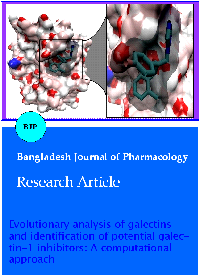Evolutionary analysis of galectins and identification of potential galectin-1 inhibitors: A computational approach
DOI:
https://doi.org/10.3329/bjp.v9i3.19716Keywords:
Galectin-1, Molecular Docking, Molecular Dynamics simulations, Principal component analysisAbstract
Galectins are a family of structurally related carbohydrate-binding proteins and some galectins play a major role in initiation, progression and dissemination of different types of tumors. Multiple sequence alignment was performed for 15 types of galectins and phylogenetic tree was constructed for studying evolutionary relationship. Among galectins, galectin-1 contributes to various events associated with cancer biology including tumor transformation, cell cycle regulation and apoptosis. Hence a rational computational approach was followed for the design of new class of glycol-mimetic inhibitors with high affinity and stability. Ten N-39-triazole analogs have been used for molecular docking with galectin-1. Based on docking studies, hexaconazole is identified as a potential inhibitor of galectin-1 for the inhibition of the tumor activity. The binding mechanism of hexaconazole to galectin-1 in the dynamics system was studied by 10 ns Molecular Dynamics simulation. Thus, our study favors more insight on hexaconazole as a promising inhibitor for galectin-1.
Downloads
376
221 Read
165
References
Amadei A, Linssen ABM, Berendsen HJC. Essential dynamics of proteins. Proteins 1993; 17: 412–25.
Barondes SH, Cooper DNW, Gitt MA, Leffle H. Galectins: Structure and function of a large family of animal lectins. J Biol Chem. 1994; 269: 20807–10.
Berendsen HJC, Van Der Spoel D, Van Drunen R. GROMACS: A message-passing parallel molecular dynamics implementation. Comp Phys Comm. 1995; 91: 43–56.
DeLano WL. Pymol. Schrodinger LLC, 2009, Portland, OR.
Giguere D, Patnam R, Bellefleur MA, St-Pierre C, Sato S, Roy R. Carbohydrate triazoles and isoxazoles as inhibitors of galectins-1 and -3. Chem Commun. 2006; 22: 2379–81.
Hope WW, Billaud EM, Lestner J, Denning DW. Therapeutic drug monitoring for triazoles. Curr Opin Infect Dis. 2008; 21: 580-86.
Humphrey W, Dalke A, Schulten K. VMD: visual molecular dynamics. J Mol Graphics. 1996; 14: 33–38.
Kundu S, Roy D. Comparative structural studies of psychrophilic and mesophilic protein homologues by molecular dynamics simulation. J Mol Graph Model. 2009; 27: 871–80.
Leffler H. Galectins structure and function: A synopsis. Results Probl Cell Differ. 2001; 33: 57–83.
Levitt M, Sharon R. Accurate simulation of protein dynamics in solution. Proc Natl Acad Sci. 1998; 85: 7557–61.
Levroney EL, Aguilar HC, Fulcher JA, Kohatsu L, Pace KE, Pang M, Gurney KB, Baum LG, Lee B. Novel innate immune functions for galectin-1: Envelope glycoproteins and augments dendritic galectin-1 inhibits cell fusion by nipah virus cell secretion of proinflammatory cytokines. J Immunol. 2005; 175: 413-20.
Lopez-Lucendo MF, Solis D, Andre S, Hirabayashi J, Kasai K, Kaltner H, Gabius HJ, Romero A. Growth-regulatory human galectin-1: Crystallographic characterization of the structural changes induced by single-site mutations and their impact on the thermodynamics of ligand binding. J Mol Biol. 2004; 343: 957–70.
Maisuradze GG, Zhou R, Liwo A, Xiao Y, Scheraga HA. Effects of mutation, truncation, and temperature on the folding kinetics of a ww domain. J. Mol. Biol. 2012; 420: 350–65.
Mercier S, St-Pierre C, Pelletier I, Ouellet M, Tremblay MJ, Sato S. Galectin-1 promotes HIV-1 infectivity in macrophages through stabilization of viral adsorption. Virology 2008; 371: 121–29.
Mesentean S, Fischer S, Smith JC. Analyzing large-scale structural change in proteins: Comparison of principal component projection and Sammon mapping. Proteins 2006; 64: 210–18.
Morris GM, Goodsell DS, Halliday RS, Huey R, Hart WE, Belew RK, Olson AJ. Automated docking using a lamarc-kian genetic algorithm and empirical binding free energy function. J Comput Chem. 1998; 19: 1639–62.
Papaleo E, Mereghetti P, Fantucci P, Grandori R, De Gioia L. Free-energy landscape, principal component analysis, and structural clustering to identify representative conforma-tions from molecular dynamics simulations: The myoglobin case. J Mol Graph Model. 2009; 27: 889–99.
Rabinovich GA, Rubinstein N, Toscano MA. Role of galectins in inflammatory and immunomodulatory processes. Biochim Biophys Acta. 2002; 1572: 274–84.
Schuttelkopf AW, van Aalten DMF. PRODRG: A tool for high-throughput crystallography of protein-ligand complexes. Acta Crystallogr. 2004; D60: 1355–63.
Turner PJ. XMGRACE, Version 5.1.19. Center for Coastal and Land-Margin Research, Oregon Graduate Institute of Science and Technology, Beaverton, OR. 2005.
Van Gunsteren WF, Billeter SR, Eising AA, Hunenberger PH, Kruger P, Mark AE, Scott WRP, Tironi IG. Biomolecular simulation: The GROMOS96 manual and user guide. Vdf Hochschulverlag AG an der ETH Zurich, Zurich, Switzer-land, 1996, 1–1042.
Varki A, Cummings RD, Esko JD, Freeze HH, Stanley P, Bertozzi CR, Hart GW, Etzler ME. Essentials of glycobiology. 2nd ed. Cold Spring Harbor NY, U.S.A, Cold Spring Harbor Laboratory Press, 2009.
Von Grotthuss M, Pas J, Rychlewski L. Ligand: Info, searching for similar small compounds using index profiles. Bioinformatics 2003; 19: 1041–42.

Published
How to Cite
Issue
Section
License
Authors who publish with this journal agree to the following terms:
- Authors retain copyright and grant the journal right of first publication with the work simultaneously licensed under a Creative Commons Attribution License that allows others to share the work with an acknowledgement of the work's authorship and initial publication in this journal.
- Authors are able to enter into separate, additional contractual arrangements for the non-exclusive distribution of the journal's published version of the work (e.g., post it to an institutional repository or publish it in a book), with an acknowledgement of its initial publication in this journal.
- Authors are permitted and encouraged to post their work online (e.g., in institutional repositories or on their website) prior to and during the submission process, as it can lead to productive exchanges, as well as earlier and greater citation of published work (See The Effect of Open Access).
